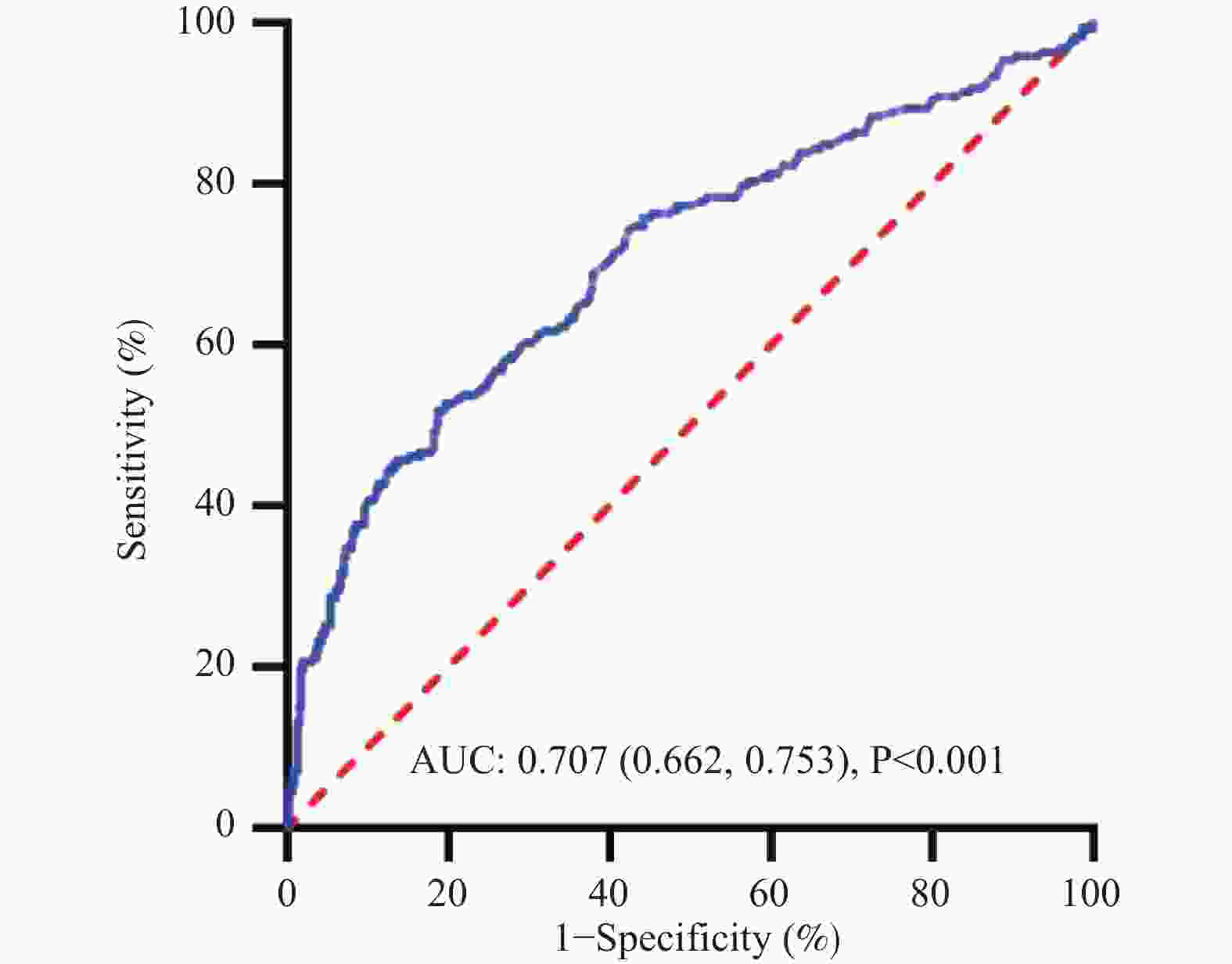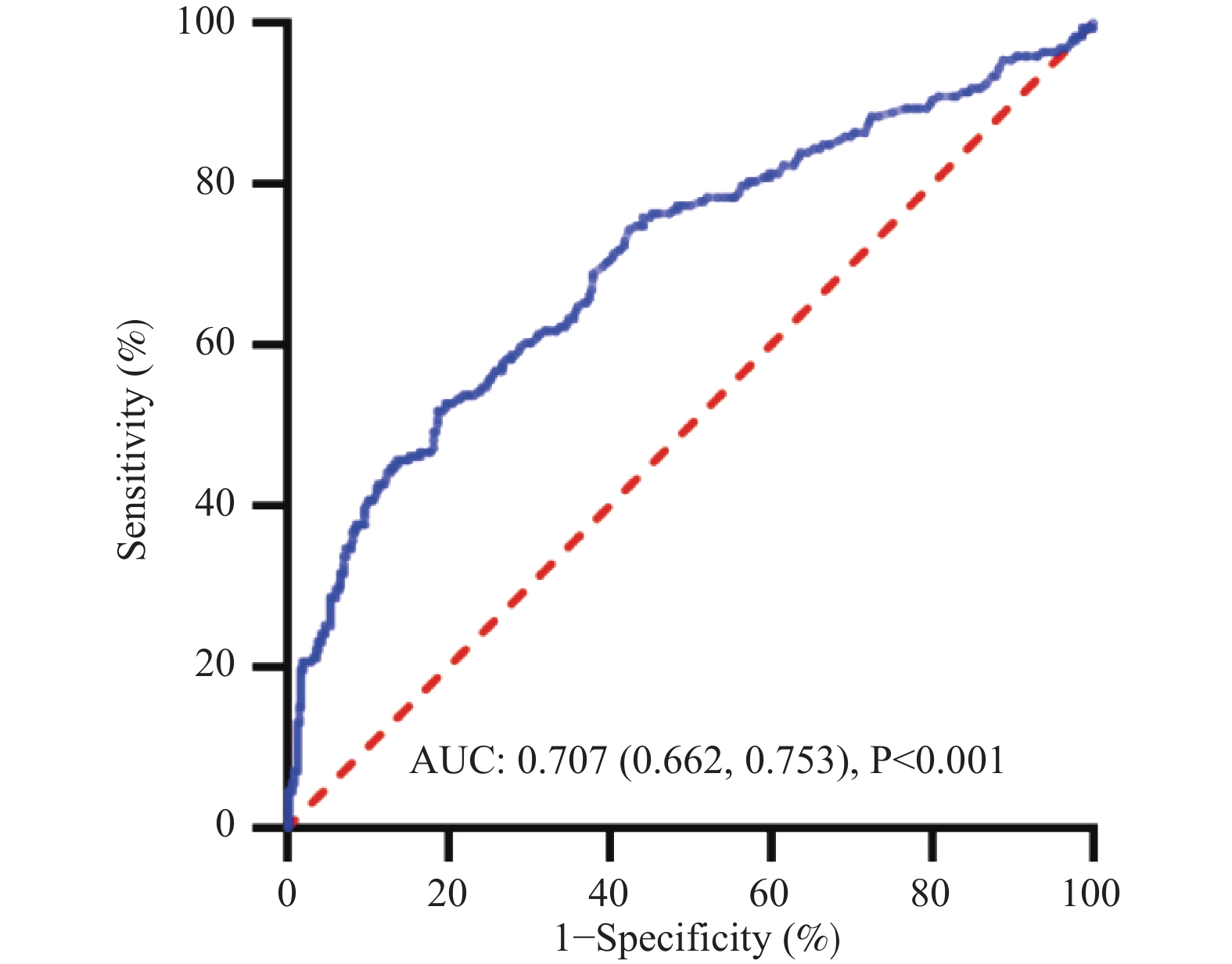Diagnostic Value of SIRI for Acute Ischemic Stroke-Associated Pneumonia of the Brain
-
摘要:
目的 探讨系统炎症反应指数(systemic inflammation response index,SIRI)对脑急性缺血性卒中相关性肺炎的预测价值。 方法 收集2017年1月至2022年12月于昆明医科大学第一附属医院确诊为脑急性缺血性卒中患者的基线资料,计算SIRI指数。根据卒中发病7 d内是否发生SAP将患者分为SAP组(665例)和非SAP组(466例)。采用Logistic回归分析SIRI指数与脑急性缺血性卒中患者发生SAP的关系,采用ROC分析SIRI对SAP的预测价值。 结果 总计665例脑急性缺血性卒中患者纳入分析,患者中位年龄为67.00 (56.00~76.00)岁,SAP的发生率为29.92%。SAP组患者年龄、房颤发生率、抑酸药物使用率、留置胃管使用率、 空腹血糖值、NHISS评分的中度和重度患者占比、白细胞数、中性粒细胞数、单核细胞数、SIRI指数占比均高于非SAP组(P < 0.05);但是,SAP组患者血红蛋白值和淋巴细胞数均低于非SAP组(P < 0.05);年龄、留置胃管、NHISS评分越高组以及SIRI指数为脑急性缺血性卒中患者发生SAP的危险因素,ROC分析显示SIRI对脑急性缺血性卒中相关性肺炎的预测准确度为0.707(95%CI:0.662~0.753,P < 0.001)。 结论 SIRI指数与脑急性缺血性卒中相关性肺炎发生相关,对脑急性缺血性卒中相关性肺炎具有预测价值。 Abstract:Objective To investigate the predictive value of systemic inflammatory response index (SIRI) for acute ischemic stroke-associated pneumonia of the brain. Methods The baseline data of patients diagnosed with acute ischemic stroke in the First Affiliated Hospital of Kunming Medical University from January 2017 to December 2022 were gathered to calculate the SIRI index. Patients were divided into SAP group (665 cases) and Non-SAP (466 cases) group according to whether SAP occurred within 7 days of stroke onset. Logistic regression was used to analyze the relationship between SIRI index and SAP in patients with acute ischemic stroke-associated pneumonia of the brain, and ROC was used to analyze the predictive value of SIRI for SAP. Results The analysis included 665 patients with acute ischemic stroke whose median age was 67.00 (56.00~76.00) years old, and the incidence of SAP was 29.92%. The age, the incidence of atrial fibrillation, the use rate of acid suppressive drugs, the use rate of indwelling gastric tube, fasting blood glucose, the proportion of moderate and severe patients in the NHISS score, the number of white blood cells, neutrophils, monocytes, and SIRI index in the SAP group were higher than those in the non SAP group (P < 0.05). However, the hemoglobin value and lymphocyte number in SAP group were lower than those in non SAP group (P < 0.05). Logistic regression analysis showed that age, indwelling gastric tube, higher NHISS score group and SIRI index were the risk factors of SAP in patients with acute ischemic stroke. ROC analysis showed that the prediction accuracy of SIRI for patients with acute ischemic stroke-associated pneumonia of the brain was 0.707 (95%CI: 0.662~0.753, P < 0.001). Conclusion SIRI index is correlated with the occurrence of acute ischemic stroke- associated pneumonia and has the predictive value for it. -
Key words:
- Acute ischemic stroke of the brain /
- SAP /
- SIRI /
- Diagnostic value
-
表 1 SAP组与非SAP组基线资料比较[n(%)/P50(P25,P75)]
Table 1. Comparison of baseline data between SAP group and non SAP group [n(%)/P50(P25,P75)]
变量 ALL(n=665) 非SAP(n=466) SAP(n=199) t/z/χ2 P 年龄(岁) 67.00(56.00~76.00) 65.00(55.00~75.00) 70.00(60.00~79.00) −4.208 <0.001* 性别 男 420(63.16) 299(64.16) 121(60.80) 0.676 0.411 女 245(36.84) 167(35.84) 78(39.20) 饮酒 0.052 0.819 无 452(67.97) 318(68.24) 134(67.34) 有 213(32.03) 148(31.76) 65(32.66) 吸烟 0.265 0.606 无 391(58.80) 271(58.15) 120(60.30) 有 274(41.20) 195(41.85) 79(39.70) 房颤 5.108 0.024* 无 615(92.48) 438(93.99) 177(88.94) 有 50(7.52) 28(6.01) 22(11.06) 冠心病 0.002 0.967 无 592(89.02) 415(89.06) 177(88.94) 有 73(10.98) 51(10.94) 22(11.06) 糖尿病 0.095 0.758 无 523(78.65) 365(78.33) 158(79.40) 有 142(21.35) 101(21.67) 41(20.60) 高血压 1.542 0.214 无 247(37.14) 166(35.62) 81(40.70) 有 418(62.86) 300(64.38) 118(59.30) 高血脂 0.652 0.419 无 496(70.53) 333(71.46) 136(68.34) 有 196(29.47) 133(28.54) 63(31.66) 既往卒中 0.007 0.933 无 516(77.59) 362(77.68) 154(77.39) 有 149(22.41) 104(22.32) 45(22.61) 使用抑酸药 19.246 <0.001* 无 165(24.81) 138(29.61) 27(13.57) 有 500(75.19) 328(70.39) 172(86.43) 留置胃管 191.258 <0.001* 无 526(79.10) 435(93.35) 91(45.73) 有 139(20.90) 31(6.65) 108(54.27) NHISS评分 137.251 <0.001* 轻度组 350(52.63) 301(64.59) 49(24.62) 中度组 236(35.49)# 148(31.76)# 88(44.22)# 重度组 79(11.88)#△ 17(3.65)#△ 62(31.16)#△ 血红蛋白(g/L) 150.00(137.00~161.00) 150.50(139.00~163.00) 148.00(134.00~160.00) −2.605 0.009* 血小板(×109/L) 199.00(163.00~241.00) 201.00(164.00~241.25) 195.00(157.00~240.00) −0.806 0.420 血糖(mmol/L) 5.60(4.81~7.10) 5.40(4.72~6.62) 6.20(5.22~8.10) −5.213 <0.001* 白细胞总数(×109/L) 7.31(6.06~9.31) 7.13(5.91~8.66) 8.74(6.58~11.57) −6.398 <0.001* 中性粒细胞(×109/L) 4.93(3.65~7.18) 4.56(3.53~6.14) 6.80(4.17~9.24) −7.344 <0.001* 淋巴粒细胞(×109/L) 1.61(1.19~2.08) 1.71(1.30~2.14) 1.33(0.96~1.84) −5.849 <0.001* 单核粒细胞(×109/L) 0.48(0.36~0.61) 0.47(0.36~0.57) 0.53(0.39~0.71) −3.893 <0.001* SIRI指数 1.42(0.83~2.62) 1.20(0.76~2.04) 2.39(1.23~4.66) −8.476 <0.001* 与轻度组比较,#P < 0.05;与中度组比较,△P < 0.05;*P < 0.05。 表 2 脑急性缺血性卒中患者并发SAP的影响因素分析
Table 2. Multivariate analysis of influencing factors of SAP in patients with acute ischemic stroke associated of the brain
变量 B Sb Wald OR(95%CI) P 年龄 0.029 0.008 12.181 1.030(1.013~1.047) <0.001* 留置胃管 否 1 是 2.224 0.281 62.575 9.247(5.329~16.046) <0.001* NHISS评分 轻 1 中 1.027 0.227 20.443 2.793(1.789~4.359) <0.001* 重 1.686 0.384 19.325 5.398(2.545~11.447) <0.001* SIRI指数 0.030 0.015 4.056 1.031(1.001~1.061) 0.044* *P < 0.05。 -
[1] 中华人民共和国国家卫生健康委员会. 《中国脑卒中防治报告2021》概要[J]. 中国脑血管病杂志,2023,20(11):783-793. [2] Go A S,Mozaffarian D,Roger V L,et al. Heart disease and stroke statistics 2014 update: A report from the American heart association[J]. Circulation,2014,129(3):e28-e292. [3] 张云芳,庄杉杉,余艳,等. PEAR1基因多态性与缺血性脑卒中的相关性研究[J]. 昆明医科大学学报,2023,44(11):135-139. [4] 周鹏,赵亚敏,李红金,等. 急性脑梗死患者合并肺部感染的影响因素分析及对预后的影响[J]. 中华医院感染学杂志,2019,29(2):212-214,223. [5] De J,Takx R,Kauw F,et al. Signs of pulmonary infection on admission chest computed tomography are associated with pneumonia or death in patients with acute stroke[J]. Stroke,2020,51(6):1690-1695. doi: 10.1161/STROKEAHA.120.028972 [6] 陈祯蕾,胡庆哲,霍颖超,等. 血清白细胞介素33对急性缺血性卒中患者并发卒中相关性肺炎的预测价值[J]. 中国脑血管病杂志,2020,17(11):655-660. [7] Smith C J,Kishore A K,Vail A,et al. Diagnosis of stroke-associated pneumonia: Recommendations from the pneumonia in stroke consensus group[J]. Stroke,2015,46(8):2335-2340. doi: 10.1161/STROKEAHA.115.009617 [8] Teh W H,Smith C J,Barlas R S,et al. Impact of stroke-associated pneumonia on mortality,length of hospitalization,and functional outcome[J]. Acta Neurol Scand,2018,138(4):293-300. doi: 10.1111/ane.12956 [9] Hannawi Y,Hannawi B,Rao C P V,et al. Stroke-associated pneumonia: Major advances and obstacles[J]. Cerebrovascular Diseases (Basel,Switzerland),2013,35(5):430-443. doi: 10.1159/000350199 [10] Li J,Luo H,Chen Y,et al. Comparison of the predictive value of inflammatory biomarkers for the risk of stroke-associated pneumonia in patients with acute ischemic stroke[J]. Clin Interv Aging,2023,11(18):1477-1490. [11] Wang R,Wen,Jiang Z,et al. The clinical value of neutrophil-to-lymphocyte ratio (NLR),systemic immune-inflammation index (SII),platelet-to-lymphocyte ratio (PLR) and systemic inflammation response index (SIRI) for predicting the occurrence and severity of pneumonia in patients with intracerebral hemorrhage[J]. Front Immunol,2023,13(14):1115031. [12] 李岸,梁小妞,刘丰韬,等. 外周血炎症标志物对急性缺血性脑卒中相关性肺炎的预测价值[J]. 中国临床神经科学,2023,31(1):28-35. [13] Xia Y,Xia C,Wu L,et al. Systemic immune inflammation index (SII),system inflammation response index (SIRI) and risk of all-cause mortality and cardiovascular mortality: A 20-year follow-up cohort study of 42,875 US adults[J]. J Clin Med,2023,12(3):1128. doi: 10.3390/jcm12031128 [14] Dziedzic E A,Gąsior J S,Tuzimek A,et al. Investigation of the associations of novel inflammatory biomarkers-systemic inflammatory index (SII) and systemic inflammatory response index (SIRI)-with the severity of coronary artery disease and acute coronary syndrome occurrence[J]. Int J Mol Sci,2022,23(17):9553 doi: 10.3390/ijms23179553 [15] Lin K,Fan F,Cai M,et al. Systemic immune inflammation index and system inflammation response index are potential biomarkers of atrial fibrillation among the patients presenting with ischemic stroke[J]. Eur J Med Res,2022,27(1):106. doi: 10.1186/s40001-022-00733-9 [16] Song Y,Zhao Y,Shu Y,et al. Combination model of neutrophil to high-density lipoprotein ratio and system inflammation response index is more valuable for predicting peripheral arterial disease in type 2 diabetic patients: A cross-sectional study. [J]. Front Endocrinol (Lausanne),2023,16(14): 1100453. [17] Zhao S,Dong S,Qin Y,et al. Inflammation index SIRI is associated with increased all-cause and cardiovascular mortality among patients with hypertension.[J]. Front Cardiovasc Med,2022,11(9):1066219. [18] 中华医学会神经病学分会,中华医学会神经病学分会脑血管病学组,中华医学会神经病学分会神经血管介入协作组. 中国急性缺血性卒中早期血管内介入诊疗指南2022[J]. 中华神经科杂志,2022,55(6):565-580. [19] 王拥军,陈玉国,吕传柱,等. 卒中相关性肺炎诊治中国专家共识(2019更新版)[J]. 中国卒中杂志,2019,14(12):1251-1262. [20] 陶俐丽. 急性脑血管患者发生卒中相关性肺炎临床特征及防治措施[J]. 中西医结合心血管病电子杂志,2022,10(28):80-82. [21] 陈照娣,黄绮芸,葛文逸,等. NLR、PLR、CRP/ALB诊断卒中相关性肺炎的价值及其对预后的影响[J]. 医学理论与实,2024,37(10):108-110. [22] Zawiah M,Khan A H,Abu F R,et al. Predictors of stroke-associated pneumonia and the predictive value of neutrophil percentage-to-albumin ratio[J]. Postgrad Med,2023,135(7):681-689. doi: 10.1080/00325481.2023.2261354 [23] Borges L,Pithon-Curi T C,Curi R,et al. COVID-19 and neutrophils: The relationship between hyperinflammation and neutrophil extracellular traps[J]. Mediators Inflamm,2020,12(2):8829674. [24] Novotny J,Oberdieck P,Titova A,et al. Thrombus NET content is associated with clinical outcome in stroke and myocardial infarction[J]. Neurology,2020,94(22):e2346-e2360. [25] Han D,Liu H,Gao Y. The role of peripheral monocytes and macrophages in ischemic stroke[J]. Neurol Sci,2020,41(12):3589-3607. doi: 10.1007/s10072-020-04777-9 [26] Li S,Huang Y,Liu Y,et al. Change and predictive ability of circulating immunoregulatory lymphocytes in long-term outcomes of acute ischemic stroke[J]. J Cereb Blood Flow Metab,2021,41(9):2280-2294. doi: 10.1177/0271678X21995694 [27] Citu C,Gorun F,Motoc A,et al. The predictive role of NLR,d-NLR,MLR,and SIRI in COVID-19 mortality[J]. Diagnostics(Basel),2022,12(1):122. [28] Arbănași E M,Halmaciu I,Kaller R,et al. Systemic inflammatory biomarkers and chest CT findings as predictors of acute limb ischemia risk,intensive care unit admission,and mortality in COVID-19 patients[J]. Diagnostics(Basel),2022,12(10):2379. [29] Yun S,Yi H,Lee D,et al. Systemic inflammation response index and systemic immune-inflammation index for predicting the prognosis of patients with aneurysmal subarachnoid hemorrhage[J]. J Stroke Cerebrovasc Dis,2021,30(8):105861. doi: 10.1016/j.jstrokecerebrovasdis.2021.105861 [30] Zhang P,Li Y,Zhang H,et al. Prognostic value of the systemic inflammation response index in patients with aneurismal subarachnoid hemorrhage and a nomogram model construction[J]. Br J Neurosurg,2023,37(6):1560-1566. doi: 10.1080/02688697.2020.1831438 -






 下载:
下载:


